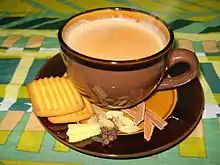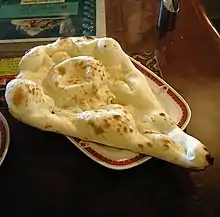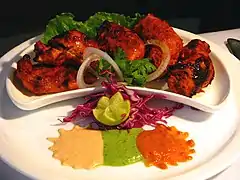 Chai served with biscuits and spices | |
| Alternative names | Spiced tea |
|---|---|
| Type | Flavoured tea |
| Place of origin | Indian subcontinent[1] |
| Associated cuisine | South Asian cuisine |
| Main ingredients | Black tea, milk, spices, sugar |
Masala chai (/tʃaɪ/, lit. 'mixed-spice tea') is a popular beverage throughout South Asia, originating in the early modern Indian subcontinent. Chai is made by brewing black tea (usually CTC tea) in milk and water and then sweetening with sugar. Adding aromatic herbs and spices creates masala chai, although chai is often prepared unspiced.[2][3]
The term chai originated from the Chinese word for tea, cha via the Hindi chai (चाय). In English, this spiced tea is commonly referred to as masala chai,[4] or simply chai,[5] even though the term refers to tea in general in the original language.
Originating in India[1][6] the beverage has gained worldwide popularity, becoming a feature in many coffee and tea houses, with many using the term chai latte or chai tea latte for their version to indicate that it is made with steamed milk, much like that used to make a caffè latte but mixed with a spiced tea concentrate instead of espresso.
History
Tea was introduced to India by the British as a popular beverage. Tea plants have grown wild in the Assam region since antiquity, but historically, Indians viewed tea as a herbal medicine rather than as a recreational beverage.[7]
In the 1830s, the British East India Company became concerned about the Chinese monopoly on tea, which constituted most of its trade and supported the enormous consumption of tea in Great Britain around 1 pound (0.45 kg) per person per year. British colonists had recently noticed the existence of the Assamese tea plants, and began to cultivate tea plantations locally. In 1870, over 90% of the tea consumed in Great Britain was still of Chinese origin, but by 1900, this had dropped to 10%, largely replaced by tea grown in India (50%) and Ceylon (33%).[8]
However, consumption of black tea within India remained low until the promotional campaign by the Indian Tea Association in the early 20th century, which encouraged factories, mines, and textile mills to provide tea breaks for their workers. It also supported many independent chaiwalas throughout the growing railway system.[9]
Tea was promoted as served Indian style, with small added amounts of milk and sugar. The Indian Tea Association initially disapproved of independent vendors' tendency to add spices and greatly increase the proportions of milk and sugar, thus reducing their usage (and thus purchase) of tea leaves per liquid volume. However, chai later firmly established itself as a popular beverage.[10]
Ingredients

Tea
Black tea is typically used as base in most chai recipes. The most common type of black tea is Assam; however, a blend of different tea variations may be used.[11] Assam, Darjeeling, and Nilgiri are the three most common types of tea used in chai in India.[12]
Spices

The traditional masala chai is a spiced beverage brewed with different proportions of warming spices. The spice mixture, called karha, uses a base of ground ginger and green cardamom pods. Other spices are usually added to this karha including one or more of cinnamon, star anise, fennel seeds, peppercorn, nutmeg, cloves, cardamom seeds, ginger root, honey, vanilla, and other spices.[13][14]
Masala chai in western India often excludes clove and black peppercorn. A small amount of salt is often added to chai in the region of Bhopal.[15] The Kashmiri version of chai is brewed with green tea instead of black tea and has a more subtle blend of spices with a pinch of salt. This version is a bit savory and is pink in color, due to the addition of baking soda.[16]
Milk
Traditionally in India, water buffalo milk is used to make chai.[17][18] Although whole milk is usually used in masala chai, alternative dairy milk such as soy milk or skim milk is also a preferred option across the world.[19]
Sweetener
White sugar, brown sugar, Demerara sugar, or honey may be used as sweetener in chai. Jaggery may also be used as a sweetener.[20]
Preparation
The simplest traditional method of preparing masala chai is through decoction, by actively simmering or boiling a mixture of milk and water with loose-leaf tea, sweeteners, and whole spices. Indian markets all over the world sell various brands of chai masala, (Hindi: चाय मसाला, romanized: chāy masālā, lit. 'tea spice') for this purpose, though many households or tea vendors, known in India as chai wallahs,[21] blend their own. The solid tea and spice residues are strained off from masala chai before serving.
A common Maharashtrian practice for preparation of one cup of chai is to first combine one half cup of water with one-half cup of milk in a pot over heat. Sugar may be added at this point or after. Ginger is then grated into the mixture followed by adding a "tea masala". Although the ingredients may vary from region to region, "tea masala" typically consists of crushed ginger, crushed cardamom, lemongrass, cloves, and cinnamon.[22] The mixture is brought to a boil and 1 teaspoon of loose black tea[23] is added. The chai is immediately taken off the heat, covered, and allowed to sit for about 10 minutes to allow the black tea to infuse into the chai. The chai is then strained and served.
Consumption of tea in the Indian subcontinent

Small vendors (called chaiwalla in Hindi/cha-ola in Bengali) are found by the side of every highway, road and alley – often the only establishments that will be open through the night. They generally also sell tobacco and snacks. Many will deliver tea to people's places of business in a chaidaan, a wooden or metal frame carrier for cups.[24]
In the metropolitan city of Mumbai, roadside tea stalls serve smaller cups of tea at a lower budget which is referred to as 'cutting chai', the term 'cutting' referring to the halving of quantity contained in a full cup to reduce the cost of the cup of tea.[25]
In Pakistan, masala chai is usually brewed with milk and sweetened with spices like nutmeg, cinnamon and/or cloves.[26]
Consumption beyond the Indian subcontinent
Masala chai is popular in East Africa and the Caribbean.[28][29] It is also quite popular in the GCC; but it is locally known as Karak Tea or Chai Karak (Arabic: شاي كرك, Urdu: کڑک چائے).[30]
In the West
In the West, to better simulate water buffalo milk, one may try using dry or powdered milk, along with the raw or turbinado sugar normally used in India. In addition, as milk consumption in all age groups in the West has started to decrease steadily over the last 50 years, substitutes such as oat and almond milk have emerged as an alternative to water buffalo milk as well.[31]
As an alternative to the hot tea format, several types of cold "chai" beverages have become popular in the United States. These range in complexity from a simple spiced iced tea without milk to a slush of spiced tea, ice, and milk (or nondairy creamer) mixed in a blender and topped with whipped cream.[32]
_-_img_03.jpg.webp)
Chai with added espresso is called a "dirty chai" in America, as well as "java chai", "red eye chai", "turbocharger", "chai charger", "tough guy chai", etc.[33][34]
See also
References
- 1 2 Sengupta, Sushmita. "History of Masala Chai: A Quick Dive Into The Origins of India's Favourite Drink". NDTV. Retrieved 28 August 2020.
- ↑ Banerjee, Snigdha. "The British ad propaganda & the journey from tea to chai". www.cityspidey.com. Retrieved 24 January 2023.
- ↑ Dalal, Tarla. "Indian tea recipe homemade chai". www.tarladalal.com. Retrieved 24 January 2023.
- ↑ "The History of Masala Chai (a.k.a. "Chai Tea")". Archived from the original on 27 June 2016. Retrieved 5 September 2016.
- ↑ "Definition of CHAI". Retrieved 5 September 2016.
- ↑ "A Brief History of Chai and 5 to Try (or Retry) This Fall". Archived from the original on 15 May 2016. Retrieved 5 September 2016.
- ↑ Rosen, Diana. Chai: the Spice Tea of India. Pownal, Vermont: Storey, 1999.
- ↑ M., Gilbert, Richard (1986). Caffeine, the most popular stimulant. New York: Chelsea House Publishers. p. 24. ISBN 9780877547563. OCLC 12970317.
{{cite book}}: CS1 maint: multiple names: authors list (link) - ↑ Chatterjee, Arup K. (18 August 2018). "How chai arrived in India 170 years ago". The Hindu.
- ↑ Collingham, Lizzie. (2006). "Chai: The Great Tea Campaign". In Curry: A Tale of Cooks & Conquerors, pp 187-214. New York: Oxford University Press. ISBN 0-19-517241-8.
- ↑ "What Is Chai and How to Make It". Food & Wine. Retrieved 2022-10-10.
- ↑ "Masala Chai Tea - History & How to Make It". TEALEAVES. Retrieved 2022-10-31.
- ↑ "Karha: the Heart of Chai". Hanumanchai.blogspot.ca. Retrieved 2018-05-29.
- ↑ What is Chai? Archived 2015-04-30 at the Wayback Machine
- ↑ "History of Masala Chai: A Quick Dive Into The Origins of India's Favourite Drink". NDTV Food. Retrieved 2023-02-24.
- ↑ Subramanian, Sribala (2020-01-29). "The Art and Science of Kashmir's Pink Tea". Atlas Obscura. Retrieved 2023-02-24.
- ↑ Sara Perry (1 Aug 2001). The New Tea Book: A Guide to Black, Green, Herbal and Chai Teas. Chronicle Books. p. 40. ISBN 9780811830539.
- ↑ Outside of India, such as in the United States, Canada, United Kingdom, or other European, countries whole-fat cow's milk is usually used. Powdered milk will somewhat more resemble water buffalo milk. Generally, the main part of masala chai is the masalas like Tulsi, Mulethi, Aswagandha, Tezpatta and other useful ingredients.
- ↑ "Did You Know Chai Tea Is Thousands of Years Old?". The Spruce Eats. Retrieved 2023-02-24.
- ↑ "What is Chai Tea?". www.teatulia.com. Retrieved 2023-03-12.
- ↑ "What is a chai wallah?". Chai Wallahs of India. 2013-04-20. Retrieved 30 November 2013.
- ↑ "Recipe for 5 Spice Tea | Tea". Tealicious. Retrieved 2019-05-18.
- ↑ "Masala Tea". www.teaboard.gov.in. Retrieved 2019-05-18.
- ↑ "10 objects that define Indian design". 2018-07-20.
- ↑ "Cutting Chai: Why Mumbai Loves a 'Half Cup' of Tea". NDTV Food. Retrieved 2023-07-05.
- ↑ Carolyn Black (2003). Pakistan: The People. p. 28.
- ↑ "Is Chai served in kulhad healthier?". The Times of India. ISSN 0971-8257. Retrieved 2023-12-13.
- ↑ Munishi, Michael Oresto; Hanisch, Rachel; Mapunda, Oscar; Ndyetabura, Theonest; Ndaro, Arnold; Schüz, Joachim; Kibiki, Gibson; McCormack, Valerie (2015-08-06). "Africa's oesophageal cancer corridor: Do hot beverages contribute?". Cancer Causes & Control. 26 (10): 1477–1486. doi:10.1007/s10552-015-0646-9. ISSN 0957-5243. PMC 4838015. PMID 26245249.
- ↑ Planet, Lonely; Fitzpatrick, Mary; Ham, Anthony; Holden, Trent; Starnes, Dean (2012-06-01). Lonely Planet East Africa. Lonely Planet. ISBN 9781743213124.
- ↑ "Chai Karak: The Popular Drink That's Rapidly Spreading in the Gulf". Khaleejisque. 2011-09-28.
- ↑ Stewart, Hayden; Dong, Diansheng; Carlson, Andrea. "Why Are Americans Consuming Less Fluid Milk? A Look at Generational Differences in Intake Frequency" (PDF). United States Department of Agriculture. Economic Research Service. Retrieved 28 March 2022.
- ↑ "Tazo® Chai Frappuccino® Blended Crème | Starbucks Coffee Company". Starbucks.com. Archived from the original on 2012-08-05. Retrieved 2012-08-13.
- ↑ "What's a Dirty Chai?". The Spruce. Retrieved 2018-01-31.
- ↑ Travis., Arndorfer (2006). The complete idiot's guide to coffee and tea. Hansen, Kristine. New York: Alpha Books. p. 120. ISBN 9781440626012. OCLC 489450263.
External links
- The Global Evolution of Chai Archived 2018-06-04 at the Wayback Machine




